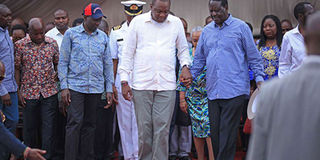Intrigue over Uhuru-Raila peace deal simmers in Kisumu

From left: Deputy President William Ruto, President Uhuru Kenyatta and ODM leader Raila Odinga leave Mambo Leo Showground, Kisumu County, after launching the Universal Health Coverage scheme on December 13, 2018. PHOTO | TONNY OMONDI | NATION MEDIA GROUP
What you need to know:
- The fear is that the Building Bridges Initiative is partly about a political pact designed to elbow Mr Ruto aside and propel Mr Odinga to State House in 2022.
- Many of the local leaders who spoke talked glowingly of the Uhuru-Raila partnership, clearly revelling in the latter’s return to the centre-stage of national leadership.
It may have been couched as a formal event to launch the government’s ambitious Universal Health Coverage scheme and various other projects, but the real import of President Uhuru Kenyatta’s visit to Kisumu was profoundly political.
It was all about the President visiting the stronghold of Opposition leader Raila Odinga, and selling and cementing the “handshake” pact between the two perennial rivals.
Even the reversal of protocol was telling. On the greeting line at Kisumu Airport and at the official function, Mr Odinga was given precedence over Deputy President William Ruto, who is often labelled a foe of the handshake’s Building Bridges Initiative.
Since the President and the opposition chief shook hands on March 9 on the steps of Harambee House to symbolically signal the end of post-election rancour and launch the drive towards national healing and reconciliation, Kenya’s politics has been turned upside down.
Mr Odinga has moved his Orange Democratic Movement in support of President Kenyatta, with National Super Alliance co-principal Kalonzo Musyoka of Wiper Democratic Party eventually coming on board after initially grumbling about the unilateral move.
DIVISION
With the Nasa presidential candidate and running mate now in bed with the government, the main Opposition alliance has been left without leadership and direction, save for sometimes lonely efforts by Amani National Congress leader Musalia Mudavadi to keep the government on its toes.
The fourth Nasa principal, Moses Wetang’ula of Ford Kenya, has been mostly invisible.
It might have been assumed that President Kenyatta would have a field day with the Opposition effectively neutered, but he has to contend with his governing Jubilee Party deeply divided as a powerful faction faithful to Deputy President Ruto and his presidential ambitions remains deeply suspicious of the handshake.
The fear is that the Building Bridges Initiative is not just about the publicly touted peace, unity, reconciliation and political reform agenda, but about a political pact designed to elbow Mr Ruto aside and propel Mr Odinga to State House in 2022.
Hostility of the DP’s camp to the deal is quite open, especially in regard to the prospects of a constitutional referendum championed by Mr Odinga that is viewed as a smokescreen to change the governing structure to Mr Ruto’s disadvantage.
CORRUPTION
Into the mix also comes the Ruto faction’s unease with President Kenyatta’s renewed anti-corruption drive, which enjoys a strong and public backing by Mr Odinga.
Parliamentarians and other allies of Mr Ruto have come out to complain that the wave of arrests and prosecutions only targets Mr Ruto’s supporters and ethnic constituency, with a view to weakening his political base ahead of 2022.
The rouses cannot be taken lightly. Jubilee is basically a union of two dominant ethnic blocs, Mr Kenyatta’s Kikuyu and Mr Ruto’s Kalenjin.
Mr Ruto not only retains solid control of his northern Rift Valley base, but has also captured support of the majority of members of Parliament from the central Kenya region who calculate that, with President Kenyatta serving out his last term, it is only prudent to hitch their horses to the next likely president.
The scenario now is that Mr Ruto effectively controls the Jubilee parliamentary group with the numbers to frustrate the President’s legislative agenda.
Kenya may well see, in coming months, President Kenyatta having to rely on Mr Odinga’s opposition MPs to push through his programmes in Parliament, while his own Jubilee MPs remain indifferent.
RELEGATED
The political undertones of the Kisumu visit were clear to see. Mr Ruto seemed to recognise that he was at best an intruder at a Building Bridges rally, reiterating his support for the Uhuru-Raila initiative and denying that he has been opposed to the handshake.
He must have been painfully conscious, however, of the very deliberate reversal in the government protocol order of precedence.
He was relegated to play second fiddle as President Kenyatta and Odinga shared the limelight.
Many of the local leaders who spoke talked glowingly of the Uhuru-Raila partnership, clearly revelling in the latter’s return to the centre-stage of national leadership.
Mr Odinga’s long-time political ally, Senate Minority Leader James Orengo, hinted tantalisingly before an excited crowd that President Kenyatta alone knows whom he would back for the presidency in 2022.
That was a loaded statement, even without mentioning names, in the context of the handshake and its presumed impact on Jubilee’s Kenyatta-Ruto succession plan.
HISTORY
In his address, Mr Odinga delved back into history, putting his pact with President Kenyatta against the background of the earlier union between their fathers, founding President Jomo Kenyatta and Vice-President Oginga Odinga, who delivered Kenya into independence from colonial rule before their bitter parting three years later.
Kisumu bears a notable resonance in Kenyatta-Odinga relationships: It was the arena of the split in 1969 when President Jomo Kenyatta and Oginga Odinga exchanged words at a public function, stones were thrown, gunshots fired and the opposition leader jailed without trial.
This time it was a celebration of the handshake, but the real import will only be seen in what the Building Brides Initiative ultimately delivers.
It is one thing for President Kenyatta and Mr Odinga to back proposed constitutional amendments at a referendum, but quite another for them to deliver their respective voting blocs.





